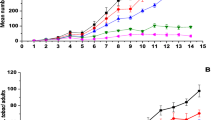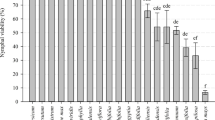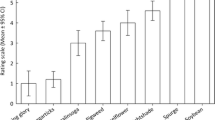Abstract
The cotton whitefly, Bemisia tabaci (Genn.) (Hom., Aleyrodidae) is increasingly a very important pest on many vegetables, field crops and ornamental plants. Therefore, controlling of this pest is still needed especially under glasshouse conditions. The specialist whiteflies’ predator, Serangium parcesetosum Sicard (Col., Coccinellidae) appears to have a great potential for the cotton whitefly control. In this study, the dynamic changes in B. tabaci populations in glasshouse cabins in response to S. parcesetosum were monitored. B. tabaci were introduced to cotton plants in three cabins in average of 50 adults per plant. One and two weeks later, adult females and males of S. parcesetosum were introduced at a rate of one female and one male per plant in the first and second cabins, respectively. The third cabin was considered as a control. The results showed that the mean number of whiteflies in the control cabin was found significantly higher than that of either when S. parcesetosum was introduced 1 or 2 weeks after the infestation with the whitefly. Also, the mean number of B. tabaci was significantly higher when the predator was introduced 2 weeks rather than 1 week after B. tabaci infestation. The maximum mean weekly number of whiteflies/plant was 192.3 in the second week, whereas it was 294.6 in the third week and 1136.4 in the fifth week, in first, second and control cabins, respectively. In the last experimental week, the mean weekly numbers were 74.7, 122.9 and 684.7 whiteflies/plant in the three cabins, respectively. S. parcesetosum has been successfully fed, reproduced and established its population on B. tabaci on cotton plants. The mean weekly number of the predatory individuals increased gradually with the progress of the experimental time. The results demonstrated that the maximum reduction percentage in B. tabaci population was 90.7 and 86.5% in the fifth week after B. tabaci infestation, when the predator was introduced 1 and 2 weeks after the infestation with the whiteflies, respectively. Nevertheless, it is speculated that an earlier release of S. parcesetosum would be more effective in the biological control of B. tabaci.



Similar content being viewed by others
References
Abboud R, Ahmad M (1998) Effect of temperature and prey-species on development of the immature stages of the coccinellid, Serangium parcesetosum Sicard (Col., Coccinellidae). Arab J Plant Prot 16(2):90–93
Ahmad M, Abboud R (2001) A comparative study of Serangium parcesetosum Sicard and Clitostethus arcuatus (Rossi) (Col., Coccinellidae): two predators of Bemisia tabaci (Genn.) in Syria. Arab J Plant Prot 19(1):40–44
Al-Zyoud F, Blaeser P, Sengonca C (2005a) Investigations on the biology and prey consumption of the predator Serangium parcesetosum Sicard (Col., Coccinellidae) by feeding on Trialeurodes vaporariorum Westwood (Hom., Aleyrodidae) as prey. J Plant Dis Prot 112(5):485–496
Al-Zyoud F, Blaeser P, Sengonca C (2005b) Longevity of the ladybird predator Serangium parcesetosum Sicard (Col., Coccinellidae) on natural and artificial nutritional sources. Mitt Dtsch Ges allg angew Entomol (Dresden) (in press)
Al-Zyoud F, Sengonca C (2004a) Development, longevity and fecundity of Bemisia tabaci (Genn.) (Hom., Aleyrodidae) on different host plants at two temperatures. Mitt Dtsch Ges allg angew Entomol (Halle) 14:373–376
Al-Zyoud F, Sengonca C (2004b) Prey consumption preferences of Serangium parcesetosum Sicard (Col., Coccinellidae) for different prey stages, species and parasitized prey. J Pest Sci 77:197–204
Al-Zyoud F, Tort N, Sengonca C (2005c) Influence of host plant species of Bemisia tabaci (Genn.) (Hom., Aleyrodidae) on some of the biological and ecological characteristics of the entomophagous Serangium parcesetosum Sicard (Col., Coccinellidae). J Pest Sci 78:25–30
Al-Zyoud F, Tort N, Sengonca C (2005d) Influence of leaf portion and plant species on the egg-laying behaviour of the ladybird Serangium parcesetosum Sicard (Col., Coccinellidae) under the presence of another natural enemy. J Pest Sci 78:167–174
Argov Y (1994) The woolly whitefly, a new pest in Israel. Alon Hanotea 48(6):290–292
Clewer AG, Scarisbrick DH (2001) Practical statistics and experimental design for plant and crop science. Wiley, Chichester, p 332
Cohen AC, Staten RT, Brummett D (1995) Generalist and specialist predators: how prey profitability and nutrient reward influence the two strategies or whiteflies as junk food. In: Proceedings of the beltwide cotton conference, San Antonio, TX, National cotton council TN, pp 71–72
Ellis D, McAvoy R, Abu Ayyash L, Flanagan M, Ciomperlik M (2001) Evaluation of Serangium parcesetosum (Col., Coccinellidae) for biological control of silverleaf whitefly, Bemisia argentifolii (Hom., Aleyrodidae), on poinsettia. Fla Entomol 84(2):215–221
Gerling D, Alomar O, Arno J (2001) Biological control of Bemisia tabaci using predators and parasitoids. Crop Prot 20:779–799
Heinz KM, Nelson JM (1996) Interspecific interactions among natural enemies of Bemisia in an inundative biological control program. Biol Control 6:384–393
Heinz KM, Parrella MP (1994) Biological control of Bemisia argentifolii (Hom.,: Aleyrodidae) infesting Euphorbia pulcherrima: evaluations of releases of Encarsia luteola (Hym., Aphelinidae) and Delphastus pusillus (Col., Coccinellidae). Environ Entomol 23:1346–1353
Hilje L, Costa HS, Stansly PA (2001) Cultural practices for managing Bemisia tabaci and associated viral diseases. Crop Prot 20:801–812
Hoddle MS, Van Driesche RG, Sanderson JP (1997a) Biological control of Bemisia argentifolii (Hom., Aleyrodidae) on poinsettia with inundative releases of Encarsia formosa (Hym., Aphelinidae): are higher release rates necessarily better? Biol Control 10:166–179
Hoddle MS, Van Driesche RG, Sanderson JP (1997b) Biological control of Bemisia argentifolii (Hom., Aleyrodidae) on poinsettia with inundative releases of Encarsia formosa Beltsville strain (Hym., Aphelinidae): can parasitoid reproduction augment inundative releases? J Econ Entomol 90:910–924
Kapadia MN, Puri SN (1992) Biology of Serangium parcesetosum as a predator of cotton whitefly. J Maharashtra Agric Univ 17(1):162–163
Köhler W, Schachtel W, Voleske P (2002) Biostatistik. Springer, Berlin, p 301
Kranthi KR, Jadhav DR, Wanjar RR, Shaker AS, Russell D (2001) Carbamate and organophosphate resistance in cotton upsets in India, 1995–1999. Bull Entomol Res 91:37–46
Legaspi JC, Ciomperlik MA, Legaspi BC (2001) Field cage evaluation of Serangium parcesetosum (Col., Coccinellidae) as a predator of citrus blackfly eggs (Hom., Aleyrodidae). Southw Entomol Sci Note 26(2):171–172
Legaspi JC, Legaspi BC, Meagher RL, Ciomperlik MA (1996) Evaluation of Serangium parcesetosum (Col., Coccinellidae) as a biological control agent of the silverleaf whitefly (Hom., Aleyrodidae). Environ Entomol 25(6):1421–1427
Malausa JC, Franco E, Brun P (1988) Establishment on the Azur coast and in Corsica of Serangium parcesetosum (Col., Coccinellidae), a predator of the citrus whitefly, Dialeurodes citri (Hom., Aleyrodidae). Entomophaga 33(4):517–519
Parrella MP, Paine TD, Bethke JA, Robb KL, Hall J (1991) Evaluation of Encarsia formosa (Hym., Aphelinidae) for biological control of sweetpotato whitefly (Hom., Aleyrodidae) on poinsettia. Environ Entomol 20:713–719
Patel CB, Rai AB, Pastagia JJ, Patel HM, Patel MB (1996) Biology and predator potential of Serangium parcesetosum Sicard (Col., Coccinellidae), of sugarcane whitefly (Aleurolobus barodensis Mask.). GAU Res J 21(2):56–60
Sengonca C, Al-Zyoud F, Blaeser P (2004) Life table of the entomophagous ladybird Serangium parcesetosum Sicard (Col., Coccinellidae) by feeding on Bemisia tabaci (Genn.) (Hom., Aleyrodidae) as prey at two different temperatures and plant species. J Plant Dis Prot 111:598–609
Sengonca C, Al-Zyoud F, Blaeser P (2005) Prey consumption by larval and adult stages of the entomophagous ladybird Serangium parcesetosum Sicard (Col., Coccinellidae) of the cotton whitefly, Bemisia tabaci (Genn.) (Hom., Aleyrodidae) at two different temperatures. J Pest Sci 78(3):179–186
Uygun N, Ulusoy M, Karaca Y, Kersting U (1997) Approaches to biological control of Dialeurodes citri (Ashmead) in Turkey. IOBC/WPRS 20:52–62
Wagner TL (1995) Temperature-dependent development, mortality, and adult size of sweetpotato whitefly biotype B (Hom., Aleyrodidae) on cotton. Environ Entomol 24(5):1179–1188
Yigit A (1992a) Method for culturing Serangium parcesetosum Sicard (Col., Coccinellidae) on Bemisia tabaci (Genn.) (Hom., Aleyrodidae). J Plant Dis Prot 99(5):525–527
Yigit A (1992b) Serangium parcesetosum Sicard (Col., Coccinellidae), new record as a citrus whitefly predatory ladybird in Turkey. Türk Entomol Derg 16(3):163–167
Yigit A, Canhilal R, Ekmekci U (2003) Seasonal population fluctuations of Serangium parcesetosum (Col., Coccinellidae), a predator of citrus whitefly, Dialeurodes citri (Hom., Aleyrodidae) in Turkey’s eastern mediterranean citrus groves. Environ Entomol 32(5):1105–1114
Author information
Authors and Affiliations
Corresponding author
Additional information
Communicated by J. Gross.
Rights and permissions
About this article
Cite this article
Al-Zyoud, F., Sengonca, C. & Al-Abbadi, S. Evaluation of Serangium parcesetosum (Col.: Coccinellidae) for biological control of Bemisia tabaci under greenhouse conditions. J Pest Sci 80, 85–92 (2007). https://doi.org/10.1007/s10340-006-0156-3
Received:
Accepted:
Published:
Issue Date:
DOI: https://doi.org/10.1007/s10340-006-0156-3




